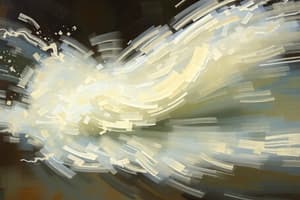Podcast
Questions and Answers
When an object is slowing down, its acceleration is in the same direction as its velocity.
When an object is slowing down, its acceleration is in the same direction as its velocity.
False (B)
What is the definition of acceleration?
What is the definition of acceleration?
The change in velocity per unit of time.
A runner starts from rest and reaches a velocity of 10 m/s in 5 seconds. The acceleration of the runner is ______ m/s².
A runner starts from rest and reaches a velocity of 10 m/s in 5 seconds. The acceleration of the runner is ______ m/s².
2
A car is traveling at a constant velocity of 20 m/s. What is the acceleration of the car?
A car is traveling at a constant velocity of 20 m/s. What is the acceleration of the car?
Match the following scenarios with the correct type of acceleration:
Match the following scenarios with the correct type of acceleration:
A person walks 50 meters to the right, then 20 meters to the left. What is the total distance traveled?
A person walks 50 meters to the right, then 20 meters to the left. What is the total distance traveled?
The shortest distance between the starting point and the final point of an object's movement is called ______.
The shortest distance between the starting point and the final point of an object's movement is called ______.
Which of the following is a scalar quantity?
Which of the following is a scalar quantity?
Distance is a vector quantity.
Distance is a vector quantity.
Distance and displacement are always equal.
Distance and displacement are always equal.
A car travels 10 kilometers north and then 5 kilometers south. What is the total distance traveled by the car?
A car travels 10 kilometers north and then 5 kilometers south. What is the total distance traveled by the car?
A car travels 30 kilometers south, then 15 kilometers east, and finally 30 kilometers north. What is the car's total displacement?
A car travels 30 kilometers south, then 15 kilometers east, and finally 30 kilometers north. What is the car's total displacement?
Match the following terms with their definitions:
Match the following terms with their definitions:
The change in position of an object is called ______.
The change in position of an object is called ______.
What is the average speed of a cyclist who travels 120 kilometers in 8 hours?
What is the average speed of a cyclist who travels 120 kilometers in 8 hours?
Match the following quantities with their corresponding descriptions:
Match the following quantities with their corresponding descriptions:
The rate at which an object changes its velocity is called ______.
The rate at which an object changes its velocity is called ______.
What is the difference between speed and velocity?
What is the difference between speed and velocity?
Acceleration always means an increase in speed.
Acceleration always means an increase in speed.
A car traveling at a constant speed can have a changing velocity.
A car traveling at a constant speed can have a changing velocity.
If a ball is thrown straight up in the air, what is its velocity at the highest point of its trajectory?
If a ball is thrown straight up in the air, what is its velocity at the highest point of its trajectory?
Flashcards
Kinematics
Kinematics
The science of describing the motion of objects using various means.
Scalar Quantity
Scalar Quantity
A quantity described by magnitude alone, without direction.
Vector Quantity
Vector Quantity
A quantity described by both magnitude and direction.
Distance
Distance
Signup and view all the flashcards
Displacement
Displacement
Signup and view all the flashcards
Speed
Speed
Signup and view all the flashcards
Velocity
Velocity
Signup and view all the flashcards
Acceleration
Acceleration
Signup and view all the flashcards
Acceleration Direction
Acceleration Direction
Signup and view all the flashcards
Final Velocity
Final Velocity
Signup and view all the flashcards
Initial Velocity
Initial Velocity
Signup and view all the flashcards
Calculating Acceleration
Calculating Acceleration
Signup and view all the flashcards
Outcome of Traveling 50m Right & 20m Left
Outcome of Traveling 50m Right & 20m Left
Signup and view all the flashcards
Outcome of Traveling 30km South, 15km East, & 30km North
Outcome of Traveling 30km South, 15km East, & 30km North
Signup and view all the flashcards
John's Displacement when traveling 25km N and 10km S
John's Displacement when traveling 25km N and 10km S
Signup and view all the flashcards
Study Notes
Motion in One Dimension
- Motion in one dimension is movement along a straight line or in a single direction.
- Motion refers to the change in position of an object relative to a frame of reference.
- Kinematics is the study of motion, describing it using words, diagrams, numbers, graphs, and equations.
Scalar Quantities
- Scalar quantities are fully described by magnitude (numerical value).
- Examples include: speed, distance, time, and temperature.
Vector Quantities
- Vector quantities are described by both magnitude and direction.
- Examples include: velocity, displacement, and acceleration.
Distance and Displacement
- Distance is the total space covered by a moving object.
- Displacement is the shortest distance from the starting point to the final point, considering direction.
Speed and Velocity
- Speed is the distance traveled per unit of time.
- Velocity is the displacement traveled per unit of time.
- Formula for speed and velocity are provided (s = d/t where s is speed, d is distance, and t is time).
Acceleration
- Acceleration is the change in velocity per unit of time.
- It is a vector quantity.
- Formula for acceleration is provided (a= (v₂ − v₁)/(t₂ − t₁), where a is acceleration, v₁ and v₂ are initial and final velocities, and t₁ and t₂ are initial and final times)
- Acceleration can be positive (speeding up in the direction of motion), negative (speeding up opposite to the direction of motion), or zero (constant velocity).
Worked Examples
- Several worked examples are provided to illustrate how to calculate speed and acceleration. These examples include values for distance, time, initial velocity, and final velocity, with clear steps for solving problems.
Studying That Suits You
Use AI to generate personalized quizzes and flashcards to suit your learning preferences.




